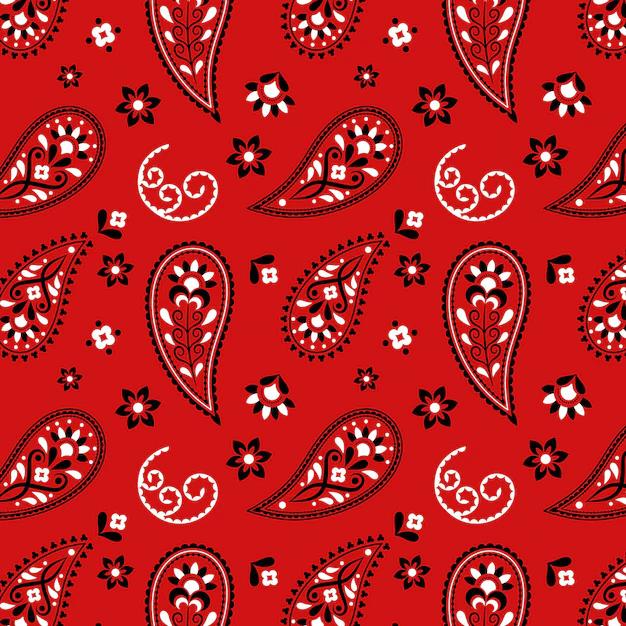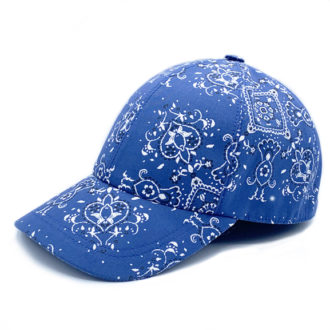Casquette Bandana, l’imprimé de légende Peslay fait son retour 15 mai 2022 – Publié dans: Ils sont Headoniste, Lifestyle
Le Bandana, c’est l’imprimé star de l’été. La marque de casquette 100 % made in France Headoniste lui rend hommage avec une casquette bandana d’exception et un bob Pirate.
Voici les histoires incroyables qui ont forgé la légende de motif star de l’été.
Un imprimé bandana cosmopolite né en Perse
Très cosmopolite, on trouve les premières traces du motif Peslay dans de nombreuses civilisations d’Asie Centrale et d’Extrême-Orient. A l’origine de ce motif, il y a le “boteh” (“bouquet de fleurs”, “arbuste”, “ronce”, “herbe” en persan), motif ornemental d’origine perse symbole d’amour et de romantisme, de la vie et de l’éternité pour la religion du Zoroastrisme.
Le motif en forme de graine représente aussi la fertilité, qu’elle a des liens avec l’hindouisme. Elle ressemble au célèbre symbole du yin et yang.
Ses premières représentations évoquent d’ailleurs très bien ce “bouquet” ou cet “arbuste”, et si vous regardez bien, encore aujourd’hui, la forme générale de la “goutte”, vous y verrez peut-être un petit arbre. Au fil des années, il devient de plus en plus géométrique et s’éloigne des représentations naturalistes du début.
Le véritable secret de l’immortalité de cette imprimé bandana réside dans la façon dont il combine conformité et indiscipline, comment il associe sa riche histoire à une puissante capacité d’adaptation, ou dans la façon dont il est ouvert à une réinterprétation sans fin et inattendue de la part des designers, stylistes et marques de mode.
Un symbole d’exotisme devenu tendance
C’est par la mythique route de la soie puis par la Compagnie des Indes que le motif débarque en fanfare dans les cours européennes du XVIIe siècle. Symbole d’exotisme, de luxe et de rareté, il est très vite adopté pour satisfaire le désir d’élégance.
Très vite, la production des pays orientaux n’est plus en mesure d’assouvir les besoins de la mode européenne, si bien que les manufactures occidentales reprennent alors la confection de ce motif, comme les manufactures de Norwich en Angleterre et de Paisley en Ecosse, qui donnera d’ailleurs le nom que l’on utilise encore aujourd’hui pour le motif.
On doit le nom bandana à Henry Monteith, un industriel de Glasgow qui fabrique ses bandanas rouges à l’aide de rouge d’Andrinople, dit aussi rouge turc. Les premiers motifs étaient picturaux. Peu à peu, les motifs ont commencé à se rapprocher des motifs communs aujourd’hui.
Car les manufactures n’ont pas le savoir-faire pour recréer les dizaines et dizaines de couleurs chatoyantes des fabricants du Moyen-Orient, et ce motif se décline donc en quelques couleurs, le bleu et le rouge. Le cachemire laisse la place à des mélanges de laine et de soie, symbole d’élégance et de chic.
Le bandana fierté de la classe ouvrière
Le bandana tel que nous le connaissons aujourd’hui est devenu populaire à la fin des années 1700, sa popularité aux États-Unis coïncide avec la révolution américaine. On dit que George Washington portait un bandana à motif cachemire, comme écharpe, la façon populaire de porter les bandanas à cette époque.
L’histoire raconte que c’est Martha Washington qui l’a créé en 1775. « Il s’agissait d’un souvenir patriotique destiné à stimuler le moral pendant la révolution américaine. Elle était en route pour rendre visite à son mari quand elle s’est arrêtée à Philadelphie. Elle voulait apporter un cadeau à George Washington et, sur recommandation de Benjamin Franklin, elle a demandé à John Hewston, un graveur, d’imprimer un dessin de George aux côtés de drapeaux militaires et de canons ».
Le bandana et son motif Paisley s’affiche désormais sur la cravate des classes ouvrières, forgerons, fermiers, marins, cow-boys, mineurs, ingénieurs de chemin de fer. Il sert à éponger le front et à protéger les voies respiratoires contre la poussière.

Dans les années 1930, les bandanas rouges étaient utilisés comme foulards par les mineurs américains. Ils l’utilisaient pour couvrir leur bouche et leur nez pour éviter la saleté et la poussière. Durant cette période, en raison de l’utilisation répandue de bandanas rouges, il serait en partie à l’origine de l’expression redneck.
La bandana, le motif chic pour une casquette fabriquée en France
Pendant la Seconde Guerre mondiale, il fait partie du vestiaire de Rosie the Riveter, les employées civiles de l’armée américaine. Le bandana en mode hippie
La vague suivante de la mode du cachemire a eu lieu dans les années 1960, sous l’influence des Beatles – dans leur phase d’influence orientale, le groupe était fou de cachemire, et John Lennon a même peint sa Rolls-Royce avec ce motif. C’est devenu l’emblème de l’ère psychédélique, avec ses motifs vertigineux de voyages à l’acide et ses couleurs vives, qui s’accordent avec l’esprit du temps des hippies, du Summer of Love de 1967, inspirés par la culture et la spiritualité indienne, qui le remettront au goût du jour.

Depuis, le motif Paisley/bandana est devenu l’une des couleurs préférées du rock ‘n’ roll. Il a été porté – avec la vigueur et l’assurance requise – par David Bowie, Prince (qui a donné à sa maison de disques et à son studio le nom de Paisley Park), Bobby Gillespie, Paul Weller, Liam Gallagher, Tupac, Rihanna, et Madonna, parmi tant d’autres. La mode s’étend désormais du hip-hop grâce aux bandanas, que de nombreux rappeurs affichent.
Petit clin d’œil à l’histoire, le troisième Maillot de l’équipe de foot de Manchester City pour la saison 2020/2021 arbore un motif imprimé paisley.

C’est pour rendre hommage aux petites et aux grandes histoires du bandana et de motif Paisley qu’Headoniste a décidé de créer une casquette et un bob bandana. La plus belle façon d’arborer l’excellence française en tête. Le bandana, accessoire unisexe par excellence, apparait cette année comme l’accessoire en vogue que les hommes, comme les femmes, s’arrachent pour agrémenter leur look de cette touche rock ou country qui fait toute la différence.

